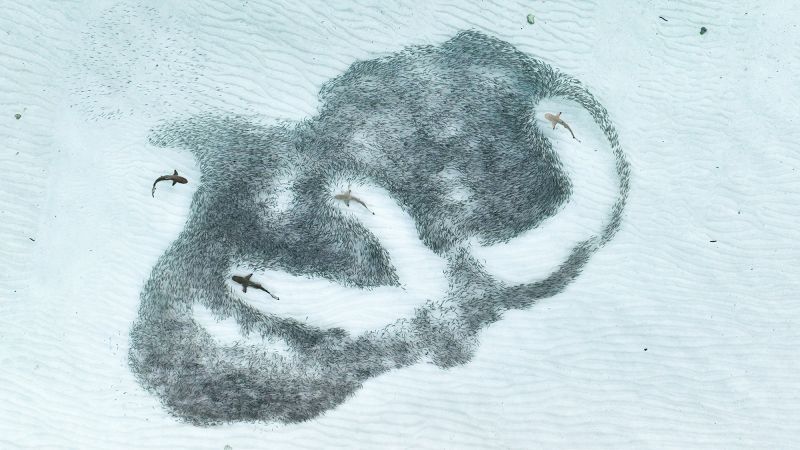The interplay between instinctual behavior and survival strategies in the animal kingdom has once again come to the forefront, as evidenced by a mesmerizing photograph of fish evading sharks in the shallow waters of the Maldives. This stunning image, which has been honored with the top accolade in this year’s Royal Society Publishing Photography Competition, provides a vivid portrayal of the predator-prey dynamics that govern life beneath the ocean’s surface. The competition showcased multiple categories and brought to light incredible art that blends science and aesthetics, highlighting the beauty of our natural world.
Angela Albi, a talented photographer and postdoctoral researcher at the renowned Max Planck Institute of Animal Behaviour in Germany, is the creative mind behind this award-winning photograph. Collaborating with skilled drone pilot August Paula, Albi managed to capture a striking instance of four juvenile sharks attacking a swarm of silverside fish. The Royal Society emphasized the photograph’s significance in its press release, underscoring how it encapsulates a raw moment of nature where life and death intertwine in the aquatic realm.
Albi herself described the conditions under which the photo was taken, noting the unique lighting during specific times of the day. “Just after sunrise or before sundown, the shallow waters of the Maldives become a clear, see-through surface,” she stated. It is during these magical moments that observers can witness the intricate interactions between reef sharks and their prey. This statement reinforces the importance of timing and environmental conditions in wildlife photography, where fleeting moments can yield profound insights into the behavior of animals.
Hugh Turvey, a member of the judging panel, commented on the photograph’s ability to convey the urgency and instinctual behavior present in nature. He noted how the school of fish displayed impressive synchrony in their movements before splitting apart to elude the hungry sharks. This encapsulation of nature’s raw instincts not only astonishes viewers but also educates them about the underlying forces at play in marine ecosystems.
The Royal Society Publishing Photography Competition featured several categories, including astronomy, behavior, Earth science and climatology, ecology and environmental science, and microimaging. Albi’s remarkable photograph triumphed in the behavior category and was also recognized as the overall winner, an impressive feat that speaks to its artistic and scientific merit.
In the astronomy category, photographer Imran Sultan explored the vastness of space by capturing intricate details of two nebulae located approximately 7,000 light years away in the Cassiopeia constellation. This piece not only showcases the beauty of the cosmos but also enhances our understanding of astrophysical phenomena.
The Earth science and climatology category was dominated by David Garcia’s awe-inspiring image of a supraglacial melting lake in Greenland. Captured with an iPhone during a fortunate moment of sunlight on a flight to a coastal town, this photograph serves as a stark reminder of the effects of climate change on our planet’s fragile ecosystems.
In another striking piece, photographer Jose Manuel Martinez Lopez brought the microcosm into focus with his photograph titled “Tired eyes,” which features a close-up view of a bark scorpion’s eyes. To create this compelling visual, he took a staggering 110 images of the specimen, showcasing the complexity and beauty present in microscopic life.
Peter Hudson’s poignant photograph of a secretary bird poised to deliver a locust as the main course won the category for ecology and environmental science. This image further reinforces the abundance of life and the relentless cycle of predator and prey that characterizes the natural world.
For anyone interested in exploring the winning and runner-up images from the competition, a selection of these stunning photographs is available to view in the accompanying gallery. These images serve as reminders of the intricacies of life on Earth, merging art with science in a visual narrative that inspires wonder and curiosity.
In addition to celebrating these contributions to scientific photography, readers are encouraged to sign up for CNN’s Wonder Theory science newsletter. This resource promises to delve into captivating discoveries and advancements in scientific understanding, offering a glimpse into the ongoing exploration of our universe and the remarkable phenomena it holds.



